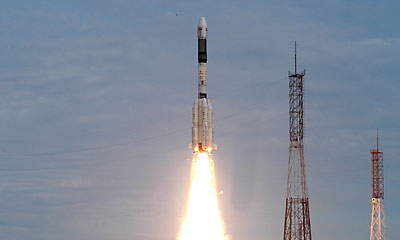US-India space cooperation: the next levelby Taylor Dinerman
|
| The key to helping India rebuild its human spaceflight program is the role of the US in the International Space Station (ISS) partnership. |
So far, no one has seriously discussed the idea that India may have an important role in human space exploration. Since the Soviets orbited Rakesh Sharma in 1984, India has lost interest in any short- or medium-term role for its citizens in space. This has been due to the Indian Space Research Organization’s (ISRO) relentless focus on finding ways to use space technology for the direct benefit of India’s national development goals. Now that India is successfully moving into the global economy, ISRO’s policy may be changing. The Moon probe may be a sign that India is aiming at becoming a full-fledged space power with civilian, commercial, military, and even human space capabilities.
Since India shows every sign of becoming a long-term strategic and economic partner of the US, it is in America’s national interest to see India develop some of its space activities in close cooperation with the US. Of course, there can be no question of an exclusive relationship on either side, but within certain political limits the relationship can be made to grow and even flourish.
The key to helping India rebuild its human spaceflight program is the role of the US in the International Space Station (ISS) partnership. President Bush has committed the US to finishing the ISS assembly process sometime around 2010. After that, the US plans to use the ISS for human spaceflight research until about 2015, when it plans to stop funding ISS operations and concentrate on the human exploration of the Moon and, eventually, Mars.
There are no official US plans for the ISS after that date. It seems unlikely that America’s partners will just abandon the orbiting complex. It is probable that, within the next couple of years, negotiations will begin covering the long-term future of the ISS. The US should consider handing off to India at least some of its ownership rights in the ISS. If this happens, one could expect future ISS crews to include at least one Indian astronaut.
India would earn its equity in the ISS by developing and building an automated logistics spacecraft, akin to Russia’s Progress or Europe’s Automated Transfer Vehicle (ATV). The Geostationary Launch Vehicle (GSLV) that ISRO has successfully used three times can put at least two or three tons into low Earth orbit (LEO). From its launch site on the Bay of Bengal, it should be able to reach the ISS with a reasonable load of fuel, water, or other supplies. This India Space Logistics Vehicle (ISLV) could be designed by India’s own space industry, with minimal help from the US and Russia.
| A low-cost Earth-to-Moon supply carrier might be a valuable business niche for the future. It would also give India a strong claim for participation in the Vision for Space Exploration. |
Europe’s ATV is the Rolls Royce of ISS resupply; the only thing more costly is the shuttle. Not only is it exceptionally costly compared to Russia’s Progress, but its complex ground control system makes it the perfect anti-model. The ATV is probably designed to give Europe’s space industry a technological starting point for a future manned capsule. That’s fine, as an industrial development policy, but it insures that the ATV is never going to be a truly cost effective delivery van.
If India were to build the ISLV as a pure ISS-oriented vehicle it would probably be even more cost effective than the Progress or America’s attempt to build an alternative access spacecraft. However, if India was to look to the future, they may want to design the ISLV so that it could evolve into a system that could deliver cargo anywhere within cislunar space, including, eventually, the surface of the Moon. A low-cost Earth-to-Moon supply carrier, launched by a future version of the GSLV or even by a non-Indian launch vehicle, might be a valuable business niche for the future. It would also give India a strong claim for participation in the Vision for Space Exploration.
After 2015 the ISS partnership will have to evolve into something much different from what it is today. The US will fade into the background while the Russians, Japanese and Europeans will share the leading roles. India—and perhaps China—will have the chance to fill the void left by the departing Americans. If NASA and the rest of the US government can properly negotiate this transition, it will be a good springboard for international cooperation beyond LEO. In any case, since India and America have already laid the basis for an effective future partnership, it is time to begin work on the next big step.
